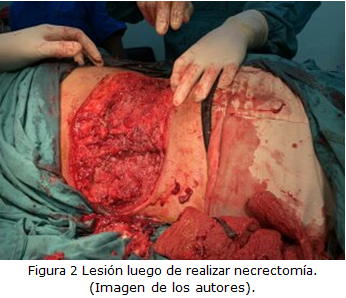Giant anthrax
Abstract
Introduction: Anthrax is the name given to the infection of several contiguous hair follicles and is caused by highly invasive pathogenic germs. It is generally caused by Staphylococcus aureus and can have systemic repercussions. The risk factors for developing this lesion are: diabetes, obesity, lack of hygiene, immunosuppression, hyperhidrosis, pre-existing dermatitis.
Objective: To make the clinical presentation of a patient diagnosed with giant anthrax.
Case report: This is a 66-year-old woman, with a history of type 2 diabetes mellitus under treatment, who attended the General Surgery service for presenting an insect bite in the lower region of the back, which was treated in the health area with antimicrobials and did not resolve. She was admitted with a diagnosis of giant anthrax and with the administration of general intravenous anesthesia, a necrectomy was performed. The postoperative period was uncomplicated and she was discharged after seven days.
Conclusions: The immediate medical care based on the parenteral administration of broad-spectrum antimicrobials, local cures and uninterrupted follow-up in the outpatient clinic of the patient with giant anthrax, ensures the effectiveness of the surgical treatment with full recovery, without having to apply grafts.
DeCS: CARBUNCLE/diagnosis; CARBUNCLE/drug therapy; CARBUNCLE/transmission; SKIN DISEASES, INFECTIOUS; ANTI-INFECTIVE AGENTS.
Downloads
References
1. Bustamante Odriozola J, Pérez Martín A, San Miguel Martín N, Martínez Revuelta D, Villar Ramos J, Maamar El Asri M, et al. Ántrax o forunculosis por Staphylococcus aureus: abordaje de las infecciones de partes blandas desde atención primaria. Med Gen Fam [Internet]. 2019 [citado 14 May 2022];8(4):181-83. Disponible en: http://mgyf.org/wp-content/uploads/2019/11/MGYF2019_046.pdf
2. Palacios Capella M. Diario de un microorganismo versátil [tesis]. Madrid: Universidad Complutense; 2019 [citado 14 May 2022]. Disponible en: http://147.96.70.122/Web/TFG/TFG/Memoria/MARIA%20PALACIOS%20CAPELLA.pdf
3. Castaño Romero CF. Estudio de comorbilidad y otros factores asociados con mortalidad en bacteriemia por Staphylococcus aureus en el Hospital Universitario de Salamanca [tesis doctoral]. Salamanca: Universidad Salamanca; 2020 [citado 14 May 2022]. Disponible en: https://gredos.usal.es/bitstream/handle/10366/145451/Casta%C3%B1o%20Romero%2C%20Carlos%20Fabi%C3%A1n.pdf?sequence=1&isAllowed=y
4. Arango Duque LC, Miranda Fontes M, Pozo Román T. Enfermedades bacterianas de la piel. Pediatr Integral [Internet]. 2021 [citado 14 May 2022]; XXV(3):140-45. Disponible en: https://www.pediatriaintegral.es/wp-content/uploads/2021/xxv03/04/n3-140-145_LauraArango.pdf
5. Carbo Palacio JA, Barco Ramírez EB. Aplicación de presión negativa en infecciones quirúrgicas, trabajo de investigación realizado en el Hospital de Especialidades Teodoro Maldonado Carbo, 2014-2017 [tesis]. Guayaquil: Universidad de Guayaquil; 2018 [citado 14 May 2022]. Disponible en: http://repositorio.ug.edu.ec/bitstream/redug/30530/1/CD%202237-%20CARBO%20PALACIO-BARCO%20RAMIREZ.pdf
6. Peiró Codina F. Staphylococcus aureus resistente a meticilina asociado a ganado porcino: implicación en clínica y epidemiología humana y evaluación del riesgo sanitario [tesis maestría]. Zaragoza: Universidad Zaragoza; 2019 [citado 14 May 2022]. Disponible en: https://zaguan.unizar.es/record/111010/files/TAZ-TFM-2019-1552.pdf
7. Mínguez Sabater H. Manejo de las infecciones cutáneas frecuentes en atención primaria [tesis]. Castellón: Universidad Jaume I; 2017 [citado 14 May 2022]. Disponible en: http://repositori.uji.es/xmlui/bitstream/handle/10234/171266/TFG_2017_MinguezSabater_Hector.pdf?sequence=1&isAllowed=y
8. Paiba Marin JC, Pérez Miranda K. Actividad antibacteriana de un jarabe elaborado con extracto hidroalcohólico de las partes aéreas de Equisetum giganteum l. (cola de caballo) frente a cepas clínicas de Staphylococcus aureus [tesis]. Lima: Universidad Inca Garcilaso de la Vega; 2019 [citado 14 May 2022]. Disponible en: http://repositorio.uigv.edu.pe/bitstream/handle/20.500.11818/4943/TESIS_PAIBA%20MARIN%20Y%20PEREZ%20MIRANDA.pdf?sequence=2&isAllowed=n
9. Rodríguez-Vega A, Sánchez-Medina MT, Lima-Sánchez J, García-Duque O, Fernández-Palacios J. Uso del colgajo vertical miocutáneo extendido de trapecio en reconstrucción de cuello. Cir Cir [Internet]. 2013 Nov-Dic [citado 14 May 2022];81(6):522-26. Disponible en: https://www.redalyc.org/articulo.oa?id=66229576010
10. Polo-Soto AI, Almanza-Pérez I. Ántrax gigante. Rev electrón Dr. Zoilo E. Marinello Vidaurreta [Internet]. 2021 Ene-Feb [citado 14 May 2022]; 46(1). Disponible en: http://www.revzoilomarinello.sld.cu/index.php/zmv/article/download/2621/pdf_753
11. Nina Tancayo WH. Presencia de portadores nasales de Staphylococcus aureus y su patrón de sensibilidad, en personal asistencial de UCI, hospitalización y laboratorio de la Clínica Arequipa noviembre 2018 [tesis]. Arequipa: Universidad Nacional de San Agustín de Arequipa; 2019 [citado 14 May 2022]. Disponible en: http://repositorio.unsa.edu.pe/bitstream/handle/UNSA/9909/BInitawh.pdf?sequence=1&isAllowed=y
12. Torres Puente S, Quintero Salcedo S, Despaigne Despaigne M. Cura local con apiterapia en una paciente con ántrax. Medisan [Internet]. 2016 [citado 14 May 2022]; 20(9). Disponible en: http://scielo.sld.cu/scielo.php?script=sci_arttext&pid=S1029-30192016000900013

Published
How to Cite
Issue
Section
License
Copyright: Camagüey Medical Archive Magazine, offers immediately after being indexed in the SciELO Project; Open access to the full text of the articles under the principle of making available and free the research to promote the exchange of global knowledge and contribute to a greater extension, publication, evaluation and extensive use of the articles that can be used without purpose As long as reference is made to the primary source.
Conflicts of interest: authors must declare in a mandatory manner the presence or not of conflicts of interest in relation to the investigation presented.
(Download Statement of potential conflicts of interest)
The Revista Archivo Médico de Camagüey is under a License Creative Commons Attribution-Noncommercial-No Derivative Works 4.0 International (CC BY 4.0).
This license allows others to distribute, to mix, to adjust and to build from its work, even for commercial purposes, as long as it is recognized the authorship of the original creation. This is the most helpful license offered. Recommended for maximum dissemination and use of licensed materials. The full license can be found at: https://creativecommons.org/licenses/












 22 julio 2025
22 julio 2025